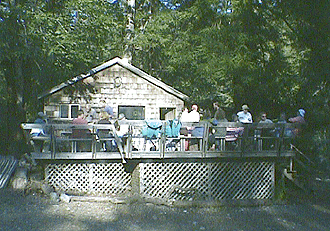![[Currents header graphic]](http://www.ucsc.edu/homeart/currents_header.gif)
![[Currents header graphic]](http://www.ucsc.edu/homeart/currents_header.gif)
August 10, 1998

|
|
Participants in the first Fred Farr Research Symposium attended a dinner at this cabin on the Landels-Hill Big Creek Reserve.
|
By Patti Parisi
A research symposium at UCSC's Landels-Hill Big Creek Reserve on July 18 showcased the results, observations, and reflections of a diverse group of researchers who have done work in the reserve, located on the Big Sur coast. Presentations covered the geology, archaeology, ecology, biology, entomology, sociology, and even the photography of this coastal wilderness ecosystem.
For the past 20 years, researchers from around the world have studied at the Big Creek Reserve, one of 33 wildland sites in the UC Natural Reserve System (NRS) and one of four such reserves managed by the UCSC campus.
"The reserve continues to make important contributions to our knowledge of wild coastal ecosystems," said resident reserve manager John Smiley, who organized the symposium with UCSC natural reserves director Maggie Fusari.
Chancellor Greenwood noted that research at the 4,200-acre Big Creek Reserve is leaving a valuable legacy for the future.
"We need to have good biological and ecological knowledge to preserve this wilderness habitat, and we need to know how to manage the land wisely," Greenwood said.
The symposium was dedicated to the memory of Fred Farr, a state senator from 1955 to 1967, charter member of the California Coastal Commission, and one of the founders of the Big Creek Reserve. Farr's son, U.S. Congressman Sam Farr (D-Carmel), said his father's "curiosity for the coast influenced a lot of lives."
The audience, crowded into the reserve's Whale Point researcher cabin, included researchers, members of the UC community, neighbors with private property next to the reserve, and members of the seven families who donated land to the reserve.
Paul Rich, an ecologist at the University of Kansas in Lawrence, has been coming to the reserve since it was first established. As an undergraduate at UCSC in 1978, Rich worked on the original survey of Big Creek's plant life. In his talk on the topography and vegetation patterns of the reserve, Rich noted that the rugged topography creates many different microclimates, resulting in highly diverse plant communities.
With its steep slopes, dramatic vistas, and elevation ranging from sea level to 4,000 feet, the reserve is not only a fascinating place to do research, but also extremely challenging, Rich said.
Adjacent to the terrestrial NRS reserve is the California Department of Fish and Game's Big Creek Marine Ecological Reserve, which Smiley also manages. Encompassing 1,200 acres of coastal waters, the marine reserve provides a pristine site for research and also offers protection for harvested species and critical habitats.
Carrie Pomeroy, an assistant research scientist in UCSC's Institute of Marine Sciences, discussed the use of the Big Creek marine reserve as a tool for managing fisheries. Pomeroy and Smiley have been working cooperatively with a group of local fishermen, allowing them to launch their boats from the Big Creek beach. The fishermen provide data to the researchers on the fish they catch outside the protected area.
Other talks in the symposium addressed topics ranging from the 6,400-year history of human occupation in the Big Sur region to the impact of the 1985 Big Sur fire on the reserve's populations of butterflies and moths. Associate Professor Norman Locks, chair of the Art Department at UCSC, showed a selection of his stunning photographs taken at the reserve (complete list of symposium presentations).
The event was as much a celebration as it was a symposium. Part of it was held outdoors among the redwoods. A dinner alongside Big Creek preceded entertainment by folk guitarist and singer Aileen Vance. Attendees camped among the redwoods or on the fog-enshrouded bluffs 600 feet above.
Smiley characterized the reserve as a window for studies of wilderness lands and wilderness marine waters. It also serves as a focal point for looking at the interface between humans and the wild environment and answering questions about how humans can coexist with nature and how human-dominated ecosystems can regain the resilience, health, and diversity of wilderness.
"The great thing about being a university program is that we are able to bring all kinds of expertise to look at these questions, ranging from art and music through anthropology, natural sciences, and public policy," Smiley said. "And the great thing about Big Creek is that we, as friends and admirers of the land and seascapes here, bring a passionate concern that there be practical, constructive answers."
John Smiley may be reached via e-mail at jsmiley@cats.ucsc.edu; Maggie Fusari is at fusari@cats.ucsc.edu.